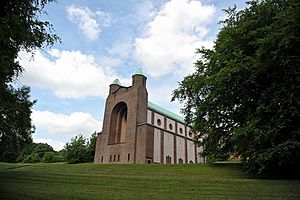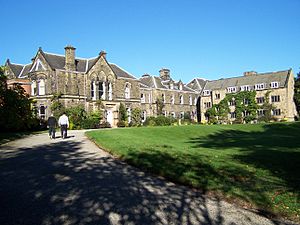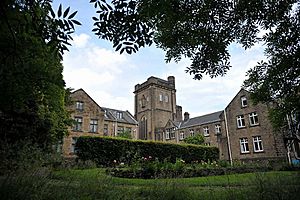Community of the Resurrection facts for kids
Quick facts for kids Community of the Resurrection |
|
|---|---|

Community church
|
|
| Country | United Kingdom |
| Denomination | Church of England |
| Administration | |
| Parish | Christ the King, Battyeford |
| Deanery | Dewsbury |
| Archdeaconry | Halifax |
| Episcopal area | Huddersfield |
| Diocese | Leeds |
| Province | York |
The Community of the Resurrection (CR) is a special group of Anglican men in England. They live together as a religious community. Their main home is in Mirfield, West Yorkshire. As of February 2021, there are 13 members. The community is very involved in the wider Anglican Communion, which is like a worldwide family of churches. They also work well with other Christian groups.
CR is dedicated to the idea of Christ's resurrection, which means coming back to life. The community's rules say they are called to show Christian hope to the world. Their shared life and worship lead to actions that help society and spread their message. They believe their purpose is to show how the world can be made new through Christ.
Contents
What the Community Does
Since it started, the community has been active in teaching and spreading its message. This happens in many parts of the Anglican Communion. Today, the House of the Resurrection is the main home and activity center for CR in Mirfield, England.
Helping the Local Area
Working with the local church area, CR runs the Mirfield Centre. This center hosts meetings and events for both church leaders and regular church members. The community is also linked to several Church of England teaching places. These include the College of the Resurrection, which CR started in 1903. It trains people to become priests. Also on the same campus are the Yorkshire Ministry Course (YMC) and the Diocesan School of Ministry.
Many people visit Mirfield, either for a day or for longer stays. This has led to a need for more buildings. There are plans for a new monastery next to the community's church. The community also has a special friendship with the Roman Catholic Benedictine St. Matthias' Abbey in Trier, Germany. A big part of their work happens in their impressive church, designed by Walter Tapper. It was fully restored between 2009 and 2012.
Retreats and Publications
The community has a retreat house where people can come for quiet reflection. They offer organized retreats for individuals and groups. CR also has its own publishing company, Mirfield Publications. This company shares their ideas and teachings through books.
As of April 2019, there are 19 "oblate brothers." These are men who live their lives connected to the community's rules, but they work outside the community.
History of the Community
Early Days in Oxford
The Community of the Resurrection (CR) grew out of the Oxford Movement. This was a movement in the Church of England in the 1800s that aimed to bring back older Christian traditions. On July 25, 1892, six priests started the community in Pusey House, Oxford. Charles Gore was the first leader.
Pusey House was not ideal for a religious community. So, the next year, the six men moved to a vicarage in Radley. Gore said they were "learning how to ride a bicycle" there, meaning they were learning how to live together. The founders wanted their community to focus on helping people. They were also "Christian Socialists." This meant they cared deeply about the poverty of working-class people. Because of this, they looked for a new home in the industrial north of England.
Moving to Mirfield
In 1898, the community found a large house in Mirfield, West Yorkshire. This became the main center for their activities. Charles Gore became a church leader in Westminster in 1894. He was still the official head of CR until 1902. But it was under his successor, Walter Howard Frere, that CR really developed its unique character.
The brothers saw their work as closely linked to the Church of England. One of their first goals was to start a college to train men for priesthood who didn't have much money. The College of the Resurrection opened in 1902. It still trains priests today. A large library of religious books was also important for the community and the college.
Growing the Community
In 1903, a group called the Fraternity of Companions was formed. This group allowed priests and regular people to be connected to CR and its way of life. The C.R. Quarterly magazine helped them stay in touch. In 1931, an order of "oblates" was created for single men. These men wanted to share in the community's way of life while working outside the community.
Retreats became a key part of their work. The brothers led retreats across the country. A retreat house was built in Mirfield in 1914 and made larger in 1926.
The brothers cared a lot about beautiful church services. Walter Frere, who was a good musician, helped develop the church's worship. To do this, they needed a proper church building. The foundation stone for a large church was laid on July 22, 1911. Even though the original plans were scaled down, it's still an impressive building. The western part was finished in 1938.
The community also used an old quarry next to the house as an outdoor theater. They held sermons, Bible classes, plays, and even political meetings there. The grounds were used for big events, like the yearly Commemoration Day, which celebrated the college's founding.
Work in Southern England
Even after leaving Oxford, the community didn't forget southern England. Charles Gore became a bishop in different areas, always focusing on helping workers. In 1914, the community was offered a house in South Kensington, London. The brothers helped soldiers during World War I. After the war, they moved to a bigger house near Holland Park. This London center stayed there until 1968. Retreats, missions, and teaching were its main activities.
Later, the London ministry moved to the Royal Foundation of St Katharine in Stepney. Here, CR shared its city work with other religious groups until 1993. Then, CR moved to an empty clergy house in Covent Garden. They ran a city ministry in central London until 2003.
The community also had retreat houses in the south. One was in St Leonards-on-Sea, Sussex (1931–1948), and another in Hemingford Grey, Cambridgeshire (1950–2010).
Ministry Around the World
CR's work in Africa became very important in the 1900s. It began early, in 1902. Bishop William Carter of Pretoria asked the brothers to help rebuild his area after the Boer War. Three brothers went to Johannesburg. They started a house to work with African miners and train local Africans in theology. Four years later, the community took over St. John’s College in the same city. By 1934, when they gave the college back to the local church, it was a thriving education center. In that year, CR was asked to run the church of Christ the King in the black neighborhood of Sophiatown.
In 1911, a new center and theological college (St Peter's Theological College) opened in Rosettenville. It grew steadily, adding schools for black children and teenagers in 1922. This college greatly influenced the church in Southern Africa.
The community was also invited to Zimbabwe in 1914. They ran a mission in Penhalonga. This became the center of their work in Zimbabwe until 1983. Their work focused on running a school for children and doing pastoral and educational work. They still have friendly connections to the Anglican Church in Zimbabwe, especially through the "Tariro" orphanage project.
Challenges After the War
Around 1960, the community was at its largest. It had over 90 brothers working in 12 houses across three continents.
CR also worked in the West Indies. From 1955 to 1969, they ran Codrington College in Barbados. Having a stable religious community there helped the students who came from far away.
They also helped in Wales. From 1945 to 1968, they ran a house called St Teilo in Cardiff. Their focus was on retreats and working with university students.
Their biggest involvement, however, was in South Africa. A new center was started in Northern Transvaal from 1945 to 1962. The community became famous for its strong stand against Apartheid. This was a system of racial segregation. Trevor Huddleston was the most well-known brother in this fight.
Because of their support for the black population, the South African government forced the college to move from Rosettenville. The center in Sophiatown closed in 1962. CR continued pastoral work in Johannesburg. They also continued theological training when Anglican bishops asked them to join a new college in Alice, Eastern Cape. The brothers joined the fight against Apartheid there. After some difficult years, the community decided to let South Africans take over the education in 1977. The Rosettenville center closed in 1986.
A house was run in Stellenbosch from 1968 to 1976. Brothers there helped with the local church and cared for Anglican students. The century of work in South Africa ended in Turffontein. The community gathered its mission there from 1986 to 2006. The brothers did typical CR work: caring for people, leading retreats, and holding conferences.
From the 1960s onwards, society and church life changed a lot in the United Kingdom. This was a big challenge for CR and other religious communities. Fewer people wanted to join religious life. Even though CR was strong, it faced difficulties. A serious crisis happened in 1974 when the superior suddenly left the community.
In the 1970s, a new idea for northern England emerged. There was a concern about a lack of spiritual understanding in big cities. CR supported Augustine Hoey CR to turn a flat in Hulme, Manchester, into a home for prayer in 1973. This project moved to a church house in Sunderland in 1977 and was called "Emmaus." Other brothers joined Hoey, and the project lasted until 1993.
Modern Focus: Education and Unity
When the mission in South Africa closed in 2006, the House of the Resurrection in Mirfield became CR's only home. This was the first time since 1898. It gave the community a chance to rethink its purpose for a new century.
The College of the Resurrection has been running for over 100 years. It is still a very important part of their work in Mirfield. In 2004, the community created a new governing body for the college. The community still plays a big role in leading the college, and a brother is currently the College Principal. The goal is to train students using the community's traditions, while preparing them for ministry today.
The college also partnered with the Northern Ordination Course in 1996, which became the Yorkshire Ministry Course. In 1998, the community opened an educational center called the Mirfield Centre. It aims to help regular Christians grow in their faith. In 2007, the Wakefield School of Ministry made this its main center.
In 2011, the Mirfield Liturgical Institute was founded. It promotes the study of church services and aims to educate people about them.
Working with Other Churches
The community has a long history of working with other Christian churches. Walter Frere visited Roman Catholic monasteries in France before joining CR. In 1928, he became the first Anglican president of the Fellowship of St Alban and St Sergius. This happened after he visited Russia in 1909.
Strong connections to Roman Catholics and Orthodox Christians have continued. In 1983, an official friendship was made with the Roman Catholic Benedictine abbey of Trier in Germany. Several brothers have also built links with the Orthodox Church in Romania. There are also connections to European Lutherans through international groups of monastics.
The church building was renovated in 2011. It is now a beautiful space. The next step is to build the new monastery. Then, the old house will be turned into much-needed facilities for the many visitors.
How CR Has Influenced Others
The community has helped train 11 bishops in different parts of the Anglican Church. Two of the founders became bishops in the Church of England. Charles Gore was Bishop of Worcester (1902–05), Birmingham (1905–11), and Oxford (1911–19). Walter Howard Frere became Bishop of Truro (1923–35).
Many CR bishops were involved in mission work outside Great Britain. James Okey Nash, one of the founders, became a bishop in Anglican Diocese of Cape Town from 1917 to 1930. He was the first of several CR bishops in Africa. Simeon Nkoane, a South African, became Desmond Tutu's assistant bishop in Anglican Diocese of Johannesburg from 1982 to 1989. Robert Mercer was Bishop of Matabeleland in Zimbabwe from 1977 to 1989.
Two CR brothers became archbishops: Thomas Hannay in Scotland and Trevor Huddleston. Trevor Huddleston was Archbishop of the Anglican Church of the Province of the Indian Ocean from 1978 to 1983. Before that, he was a bishop in Tanzania, London, and Mauritius.
In Asia, William Rupert Mounsey was Bishop of Labuan and Sarawak from 1909 to 1916. Victor Shearburn was Bishop of Rangoon from 1955 to 1966. The community also had a bishop in Anglican Diocese of Bermuda, Anselm Genders, from 1977 to 1982.
CR has had a big impact on the Anglican Church in South Africa. This is especially true through the work of brothers Raymond Raynes and Trevor Huddleston in Sophiatown. Huddleston and CR also influenced Desmond Tutu. St John's College in Johannesburg and its values are largely thanks to its founding brothers, who were all CR members. It has been a role model for many schools in Southern Africa.
Other important members include John Neville Figgis, Edward Keble Talbot, Lionel Thornton, Martin Jarrett-Kerr, Harry Williams, Geoffrey Beaumont, and Benedict Green.
Notable Visitors
Dietrich Bonhoeffer, a famous German theologian, visited CR in Mirfield in 1935. His visit inspired him to include parts of Psalm 119 in the daily prayers of his seminary. It also led him to write his well-known book Life Together.
Some important South African brothers completed their training at Mirfield. These include Fr Leo Rakale and Bishop Simeon Nkoane. The Bishop Simeon Memorial Trust is a charity that helps with education.
The Trevor Huddleston CR Memorial Centre in Sophiatown, Johannesburg, is a charity that continues Bishop Trevor's work. It especially helps young people. A new building, the Fr Trevor Huddleston memorial building, opened in September 2015. It hosts programs for small business development, youth training, and arts. It aims to bring people together and help the community. It also remembers the forced removals from Sophiatown, which inspired Bishop Trevor's book 'Naught for your comfort'. You can find more information at www.trevorhuddleston.org and www.sophiatown.net.
Visitors can take a guided tour of the area, see a small museum, and enjoy the garden cafe. They can also rent the venue and attend concerts. All profits support the work with young people.
Leaders of the Community
The head of the Community of the Resurrection is called the superior.
- Charles Gore (1892 to 1902); known as the Senior, later became a bishop
- Walter Frere (1902 to 1913); first superior, later became a bishop
- George Longridge (1914 to 1917)
- Walter Frere (1917 to 1922); served a second time
- Keble Talbot (1922 to 1940)
- Raymond Raynes (1940 to 1957)
- Jonathan Graham (1957 to 1965)
- Hugh Bishop (1965 to 1974)
- Eric Simmons (1974 to 1987)
- Silvanus Berry (1987 to 1998)
- Crispin Harrison (1998 to 2003)
- George Guiver (2003 to 2018)
- Oswin Gartside (2018 to present)





